Wednesday 9th to Tuesday 22nd February 2022
The passage from Phuket to the Maldives is over 1500 nm, which we had estimated would take us around 12 days. It’s been over 4 years since we’ve done a sail of over 1000 miles so I was feeling just a bit nervous about how well I’d cope with such a long passage. But Vega was in excellent condition after all the work done, we’d got everything ready, equipment working, grab bag sorted, meals ready for those difficult first few days at sea, everything ticked off the pre-passage check-list.
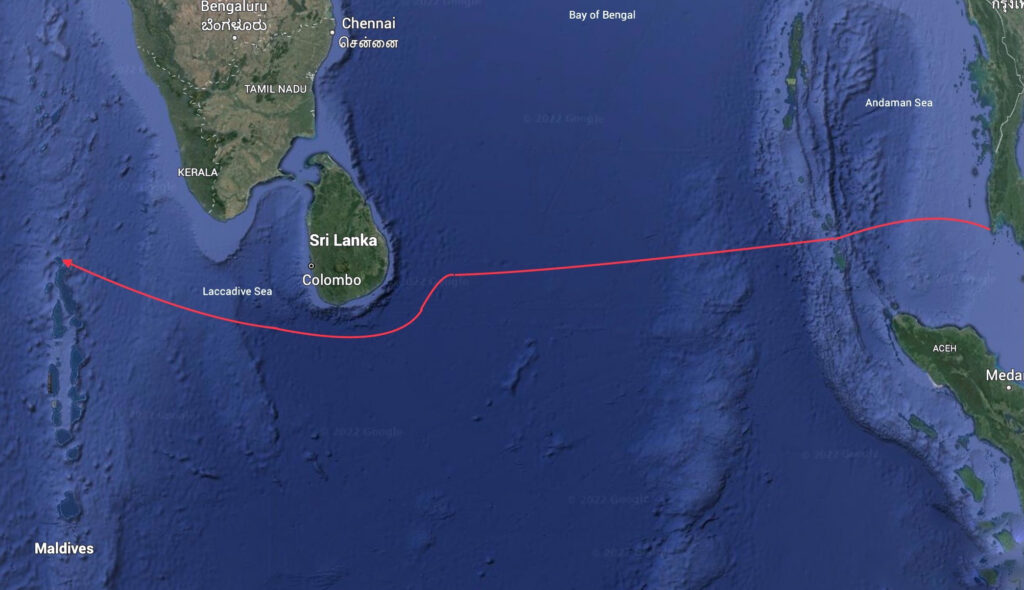
We had initially hoped to set off with Colin and Izzi on Endorphin Beta and Jon on Hecla but we were delayed whilst Hugh had the lump on his cheek removed. They had left Phuket before us but problems with their rudder meant Colin and Izzi had had to return to the Boat Lagoon Marina to get their boat lifted out of the water. In the meantime Jon had continued on towards the Maldives and was four days ahead of us.
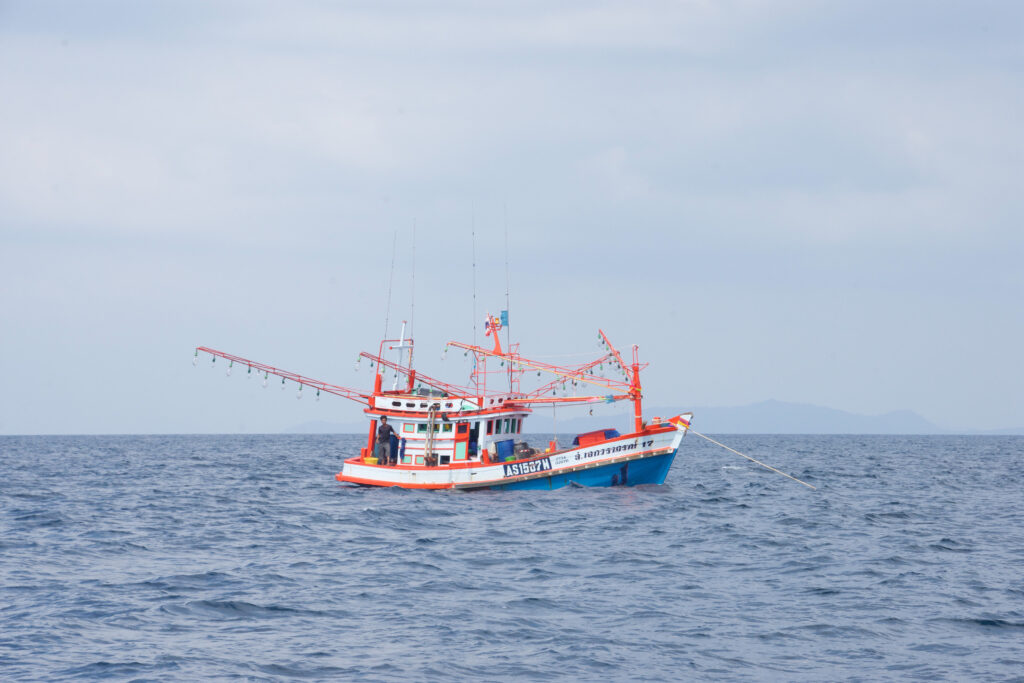
Hugh has been using weather forecaster Des Cason in South Africa to advise us on routes and to help decide when to depart. On the morning of departure Des warned of a trough of low pressure directly ahead of us … “so you will just have to grin and bear it as it passes over you”. We set off just before noon, passing several fishing boats at anchor during the day, and by dusk we could see dark, low clouds approaching and, on radar, a large yellow shadow indicating a squall coming our way. We just had time to drop the mainsail, furl the genoa, put the engine on and close all the windows and hatches, before the squall hit us with torrential rain, winds over 30 knots from the starboard side causing Vega to tilt over, a massive flash of lightning surrounding us and an immediate boom of thunder. As we slowly motored on we watched out on radar for nearby fishing boats as visibility was down to less than 50 metres with all the rain. It was quite terrifying and presumably what Des had meant by “grin and bear it”. More lightning as the storm slowly moved away to the NW and after an hour conditions had improved enough for me to heat up for supper the chicken casserole I’d made before leaving.
As the wind increased over the next few days, the sailing became more rough and unpleasant. The Indian Ocean was being typically ‘boisterous’ as Hugh puts it. At times we had the relief of a few hours of pleasant sailing, at others the wind increased to over 20 knots with the boat rolling from side to side. Then the wind would drop, the sails flap and we just floundered around unpleasantly. By night for the first two days we were surrounded by the lights on the horizon of numerous fishing boats, the bright green lights of the squid fishing boats and by flashes of lightning on the horizon.
I always find the first few days of any long passage difficult, mild seasickness makes me feel nauseous and low in mood and in energy levels. This was no exception and by day 2 at sea I was feeling unhappy, fed up and fearful, wondering how I’d cope with the next two weeks at sea, let alone the difficult passage through the Mozambique Channel and around South Africa and I began wondering why we hadn’t shipped Vega back to the U.K. I wasn’t sleeping well and was feeling increasingly low and scared, fretting about what I’d do if Hugh fell overboard in big seas and I couldn’t find him or get him back on board (incidentally we have fitted new AIS trackers into our life jackets which would hopefully enable us to locate a man overboard).
Part of the energy to recharge our batteries whilst we are sailing comes from the solar panels, but even more should come from the Duogen propellor which we tow behind. On a couple of occasions the Duogen stopped working and, raising it, we found plastic bags or fishing ropes wrapped tightly around it. There is a lot of rubbish in the sea here, which washes along the Straits of Malacca into the Andaman Sea. Even when it was turning the Duogen wasn’t charging the batteries properly, a problem with the regulator dumping the power Hugh decided, but he was unable to come up with a solution despite contacting the manufacturers. The casualty of this was sadly my new freezer which we had to empty and eat our way through the contents over the next few days.
We heard from Jon on Hecla, about 500 miles ahead of us, that he’d experienced squalls overnight and had also spotted long-line fishing trawls which you don’t want to get caught up in. In the morning a fishing boat had changed course towards him, cut across his bow and then circled around him, the crew shouting and gesturing. Whilst it’s hard to know whether they were just after some water or beer, or had hostile intentions, Jon throttled up and headed away.
By day 4 we were passing through the Sombrero Channel, the gap between the long chain of the Andaman and the Nicobar Islands which run north to south for 500 miles, and are administered by India. To visit the Andaman islands you need an Indian visa and permit, and there is Indian-style bureaucracy involved, such as having to submit a detailed itinerary and having to report your location twice a day by radio. A stop here would also have meant a diversion 250 miles north to the only port of entry, Port Blair, to check in to the country and then out again. As a result few yachts stop en route west and, anyway, they had recently closed their borders due to Covid. It is on one of the Andaman Islands, North Sentinel, that the reclusive tribe, the Sentinelese live, completely cut off from civilisation. It is absolutely forbidden to visit, partly for fear that western viruses could wipe out the population but also the natives are hostile to any attempts of contact by the outside world. You may remember that in 2017 a young American missionary was landed on the island determined to save them from eternal damnation but disappeared, presumably speared to death on the beach.
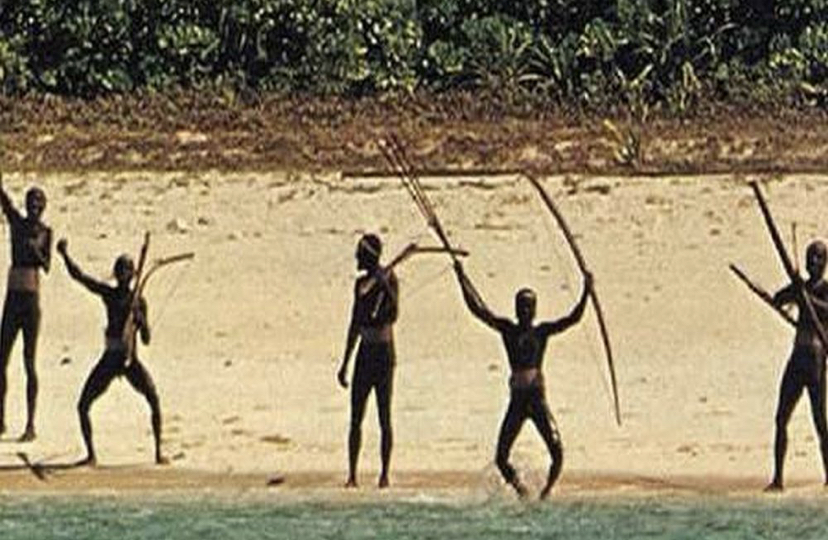
The Nicobar Islands, to the south of our route, are shrouded in mystery. It is next to impossible to get a permit from the Indian Government to visit them, the reasons given include the special ecology and the aggressive nature of the tribes who live there. So we sailed on past and could see the low lying islands of the Andamans on the horizon to the north and the Nicobars to the south. We were honoured to receive a visit from a pod of about 30-40 dolphins who played by the bow for around 20 minutes before disappearing as suddenly as they’d arrived. Dolphins always lift the mood, and I sat at the bow enjoying their frolicking and calling out to them.
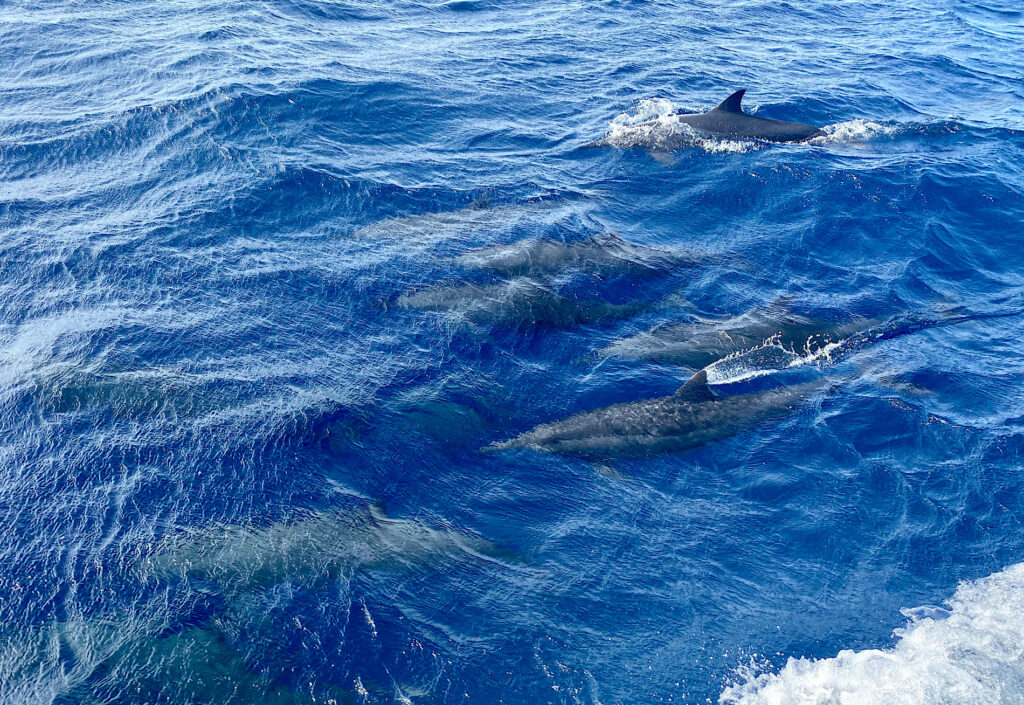
A certain amount noise is inevitable on a boat, but whether the sound of the rigging banging and the water rushing past the hull keeps you awake is to some extent a state of mind. A loose tin of beans rolling around in a cupboard or saucepan lids clattering together means I need to go around stuffing spare tea towels into gaps before I try and get a few hours sleep. One night, however, the sound of creaking coming from the mast even prevented Hugh from sleeping. He went on deck to investigate but there was nothing obvious he could fix and a liberal dose of WD40 soon stopped the noise. In the morning he was still worried as further investigation suggested there was movement at the bottom of the mast where it joins the deck. Several text messages later to Jai, the rigger, and to Colin (a bit of a rigging expert and still stuck in the marina) it was decided that our new shrouds, the wires which help support the mast, needed tightening, which Hugh was able to do.
By about the sixth day at sea (which just happened to be Valentines Day) I was starting to enjoy the sailing. The sea was less rough, the boat not so rolly with an easier motion through the water, the winds a steadier 15 knots and Vega was speeding along at over 7 knots much of the time (although almost 2 knots of this was probably current). On day 7 we did 162 miles in 24 hours, averaging just under 7 knots, an all time record for Vega.
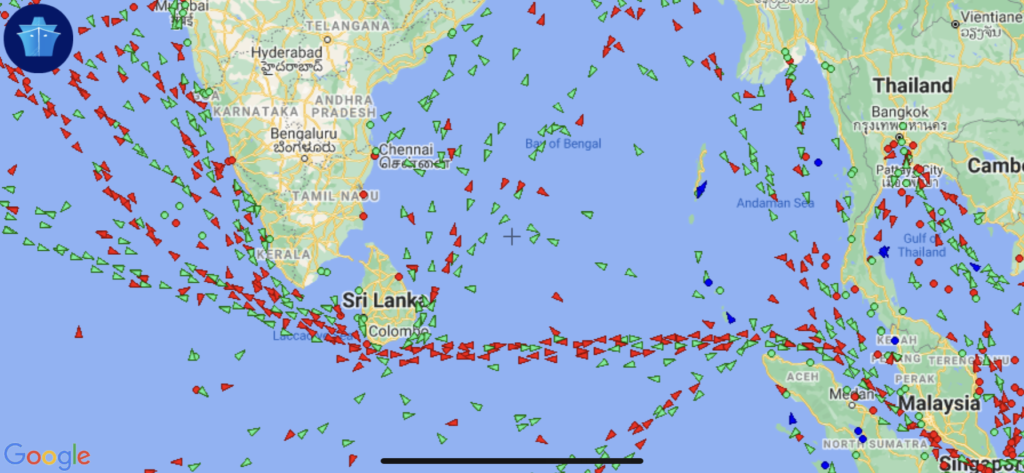
One of the world’s busiest shipping lanes passes around the southern tip of Sri Lanka with cargo ships and oil tankers travelling between the Suez Canal and east Asia. We had been to the north of this and needed to cross to the south whilst avoiding the relentless barrage of ships, some over 1000 ft long, travelling this route. Our Raymarine plotter shows information received from our AIS transponder about the name, location, speed and direction of travel of other ships and, importantly, our closest expected point of approach to them. As we neared the shipping lane on the night of day 7 we started to see the lights of a large cargo ship on the horizon, but its AIS information was not appearing on the plotter. Panic! Years ago we had crossed the English Channel in Vega at night, in a storm, when our plotter had broken and I didn’t want to repeat the experience. Much of the night was spent scouring manuals, messaging Colin and Jon, and checking for loose wiring, before deciding that the AIS transponder was working fine but it just wasn’t communicating with the plotter. Once we realised that the Navionics app on our iPads could pick up the AIS data alright, panic over. At first light we turned to port and sailed across the shipping lanes, calling up a couple of cargo ships on the VHF radio to make sure they were aware of us, and gratefully seeing several others change course to avoid us. In the meantime Endorphin finally set off from Phuket, straight into a thunderstorm!
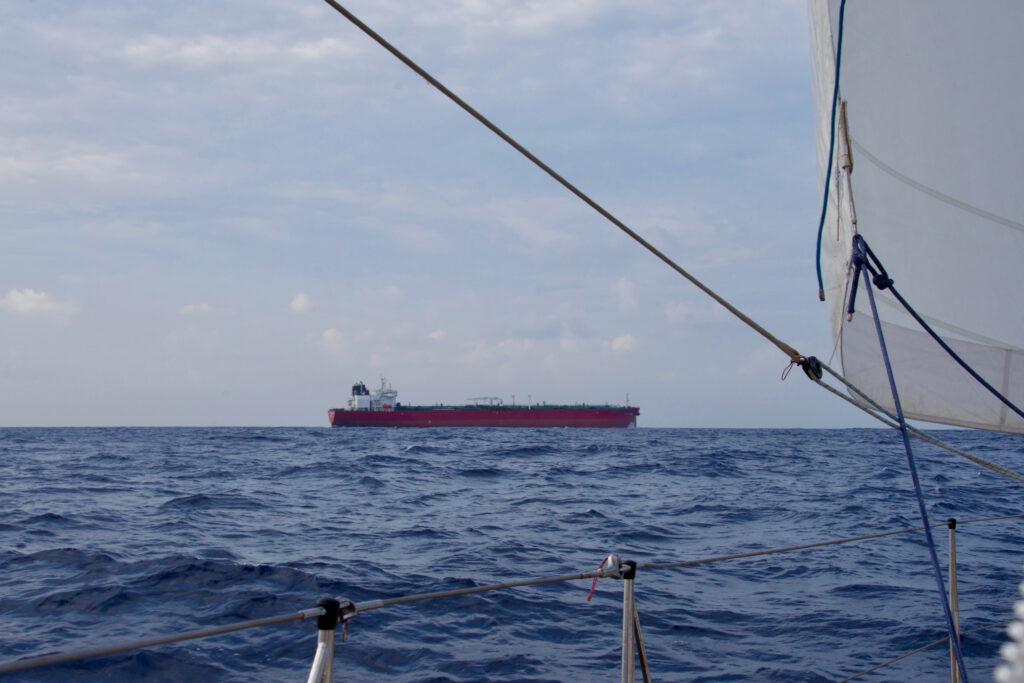
As we approached the bottom of Sri Lanka on day 9 we had well nigh perfect sailing conditions. The sea state was relatively slight and, with winds on the beam of 12-15 knots, Vega sailed beautifully, keeping well to the south of the shipping lanes. Hugh was blissfully happy. He declared ‘this is passage making at its best’ and he loves his boat. She was sailing better than ever, the sun was shining, the winds perfect and we were making good speeds towards our destination. As things go wrong he was working out, with the invaluable help of Jon and Colin, how to fix them and was learning about boat electronics etc, as well as gaining in confidence. Time passed reading, cooking, eating, listening to podcasts – the Archers Omnibus with lunch. Near to dusk we’d eat supper in the cockpit listening to music and watching the sunset. I was sleeping better, catching up during the day with naps and I even had the energy to clean the heads. With the gentler seas and my body getting used to the erratic motion of the boat, the noises and the interrupted sleep patterns as we did 3-4 hour watches, I started to fall asleep quickly and to sleep well and deeply.
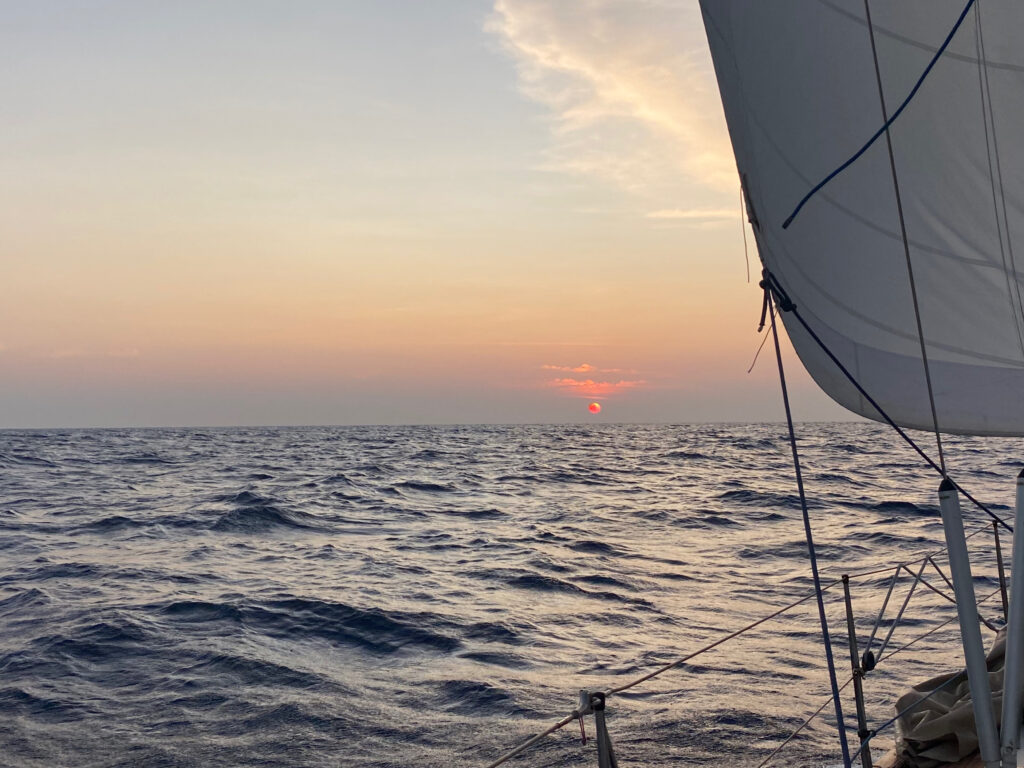
When we were first looking into equipment needed for a circumnavigation we were persuaded, at the London Boat Show, to buy the ‘Iridium Pilot’ system for communication at sea, the ‘Rolls Royce of global satellite communication’. It enables us to send emails, get up to date weather forecasts etc and make emergency satellite phone calls. Unfortunately it has proved much too expensive to surf the Internet, gobbling up data and dollars if we weren’t careful. It also means we have a strange mushroom mounted on the stern of Vega (which I’ve never seen on any other yacht). Most of our friends use a much simpler system, ‘Iridium Go’. Over the years Hugh has developed a rather strange relationship with Ed Wildgoose, the owner of Mailasail and developer of the software it uses, sending off increasingly frustrated and desperate emails asking why their email system won’t do what he wants and is using up all the data allowance. Ed sends back patronising and technically incomprehensible replies. Lately, however, the replies have been much more helpful and empathetic…. we wonder if Ed has been on a course.
Hugh now has a new toy… a Garmin InReach. This simple handheld device allows unlimited text messages to be sent at sea for £50 a month and also allows tracking of our position. He now spends much of the day composing messages to send and sharing position and sailing information. It has proved invaluable with our latest equipment problems as messages go to and fro between Hugh, Colin and Jon, suggesting possible solutions.
At midday on day 10 we passed the southernmost tip of Sri Lanka, passing the occasional fishing boat and tanker, having to change course to avoid some fishing nets and fishing boats. We heard that Endorphin had had a terrible night when a sudden squall and over 40 knots of wind had ripped their mainsail as they tried to furl it.
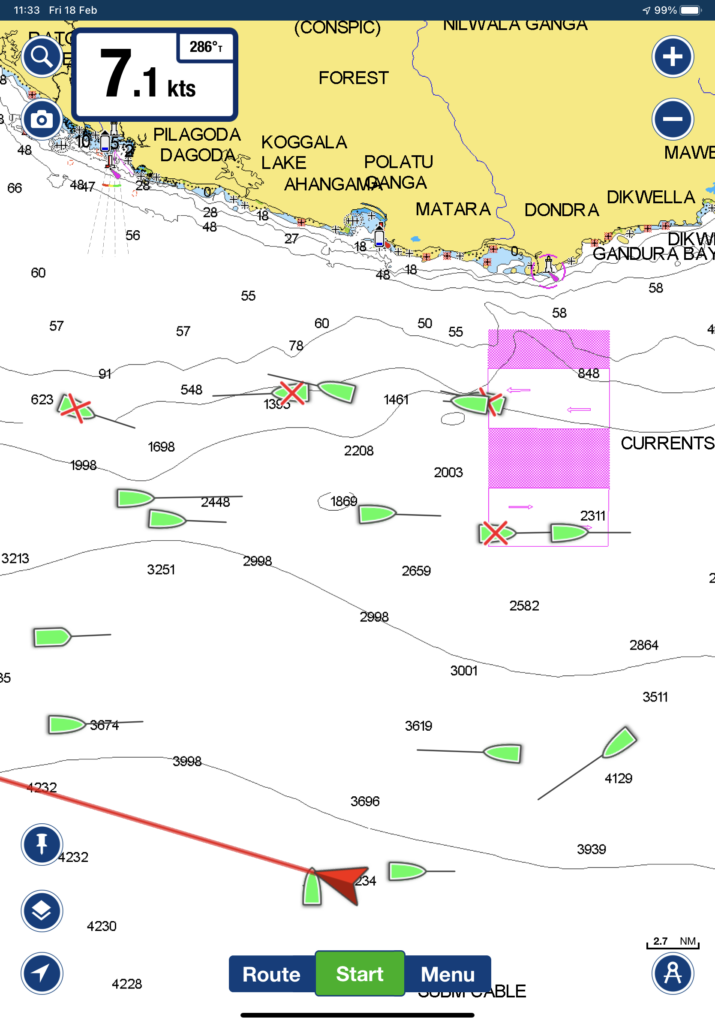
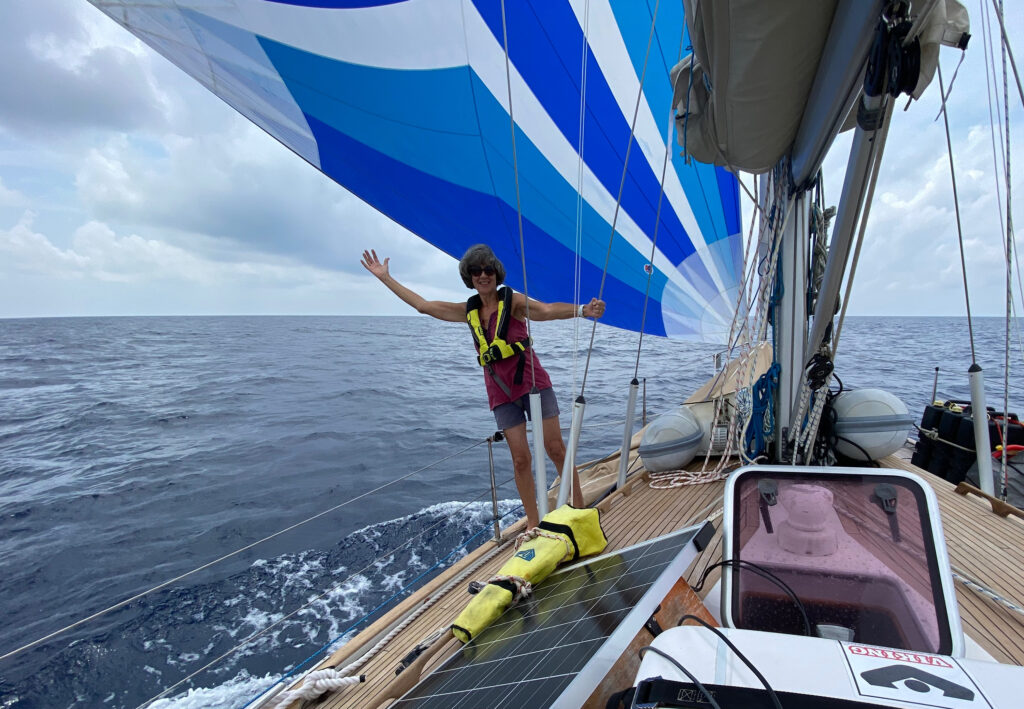
As the wind dropped we sailed with the cruising chute until the wind almost completely died and we had to motor overnight. The following morning brought a flat, mirror-like sea, the northeast wind masked by the land mass of Sri Lanka. As we passed this area the wind slowly increased and gave us wonderful sailing with the cruising chute on a beautiful sunny afternoon.
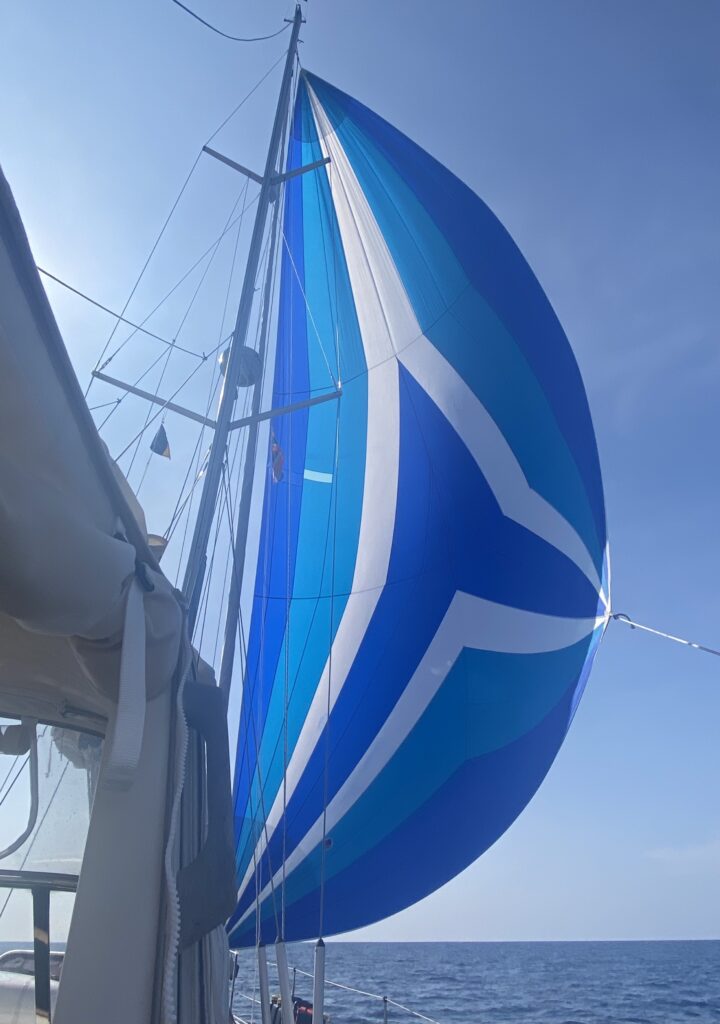
Later in the day Endorphin reported smoke in their engine room that they eventually determined was caused by the drive belt to their water maker which had been slipping. We received a message that made us concerned that they might be about to give up. We hoped not.
The night of day 11 was dreadful as wind funnelled down between Sri Lanka and India causing a confused, rough and chaotic sea, the boat rolling and jerking around. When I tried to sleep I couldn’t, being flung to and fro in bed with a cacophony of noises from the boat, the wind and the sea. Over the next two days conditions eased so by day 13 we were motoring in no wind and a flat glassy sea. We only had 75 miles to go so, to ensure we didn’t arrive in the dark, we turned off the engine and drifted. I swam off the back of the boat in the clear, blue sea, an extraordinary feeling knowing there is almost 3km of water below. At one point Hugh spotted five large fins approaching us before they veered away. Too big for dolphins and not behaving like sharks. Pilot whales?
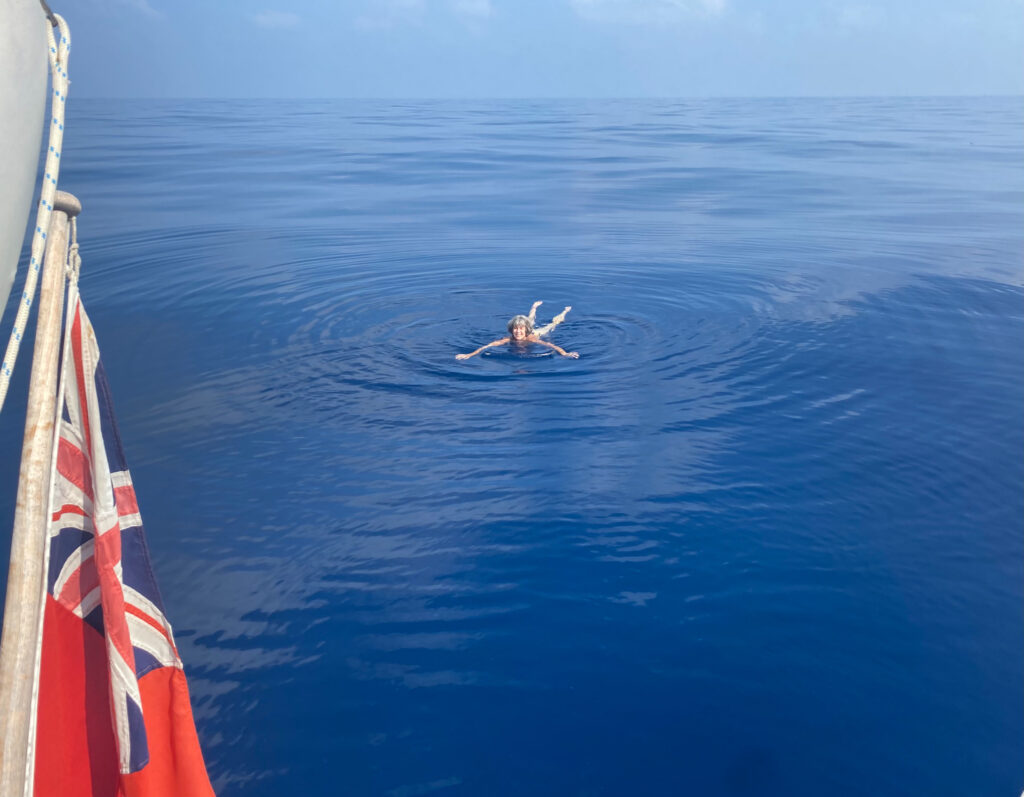
On our last night at sea a gentle wind enable us to sail on the smooth sea at an easy 5 knots, the sunset a glorious vermillion which hung in the sky for almost an hour. The moon didn’t rise until near midnight and the blackness of the night was only relieved by pinpricks of light from the millions of stars as we lay in the cockpit listening to the music and raw emotion of Nina Simone. A magical time.
Early on the morning of our fourteenth day at sea some of the low lying islands of the northern Maldives appeared on the horizon, and as we approached we could make out four individual islands, all covered in green vegetation and fringed by golden sand. Hugh hurriedly took down our Thai courtesy flag and raised the Maldives flag and, below it, the yellow Q flag on our starboard spreader. It was exciting to get a call on VHF from Jon who had arrived four days earlier. All the discomforts of the voyage were quickly forgotten.
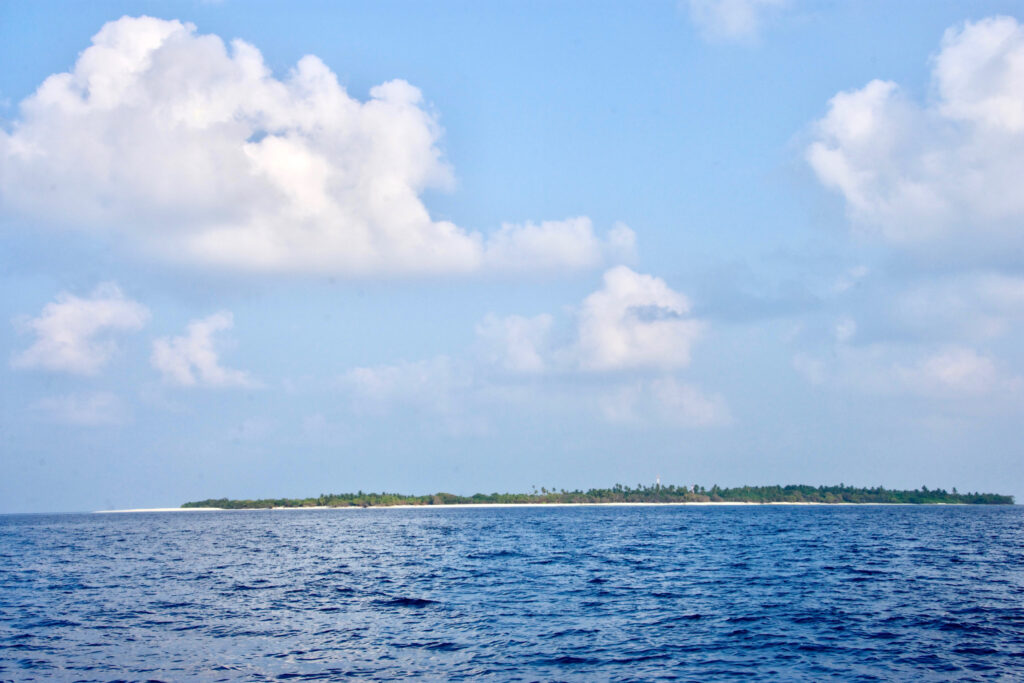
As we rounded the south of the island of Uligan, through the pass between islands into the atoll, we could see four other yachts at anchor including Hecla, a small harbour, a few rooftops and a squat mosque amongst the palm trees, two cellphone towers and a strip of sandy beach.
We dropped anchor in 20 metres outside the reef and called our agent, Asadhulla. A few hours later he arrived in a small boat along with customs, immigration and health. After filling in numerous forms, our passports were stamped, Asadhulla provided us with local SIM cards, and we were free to explore.
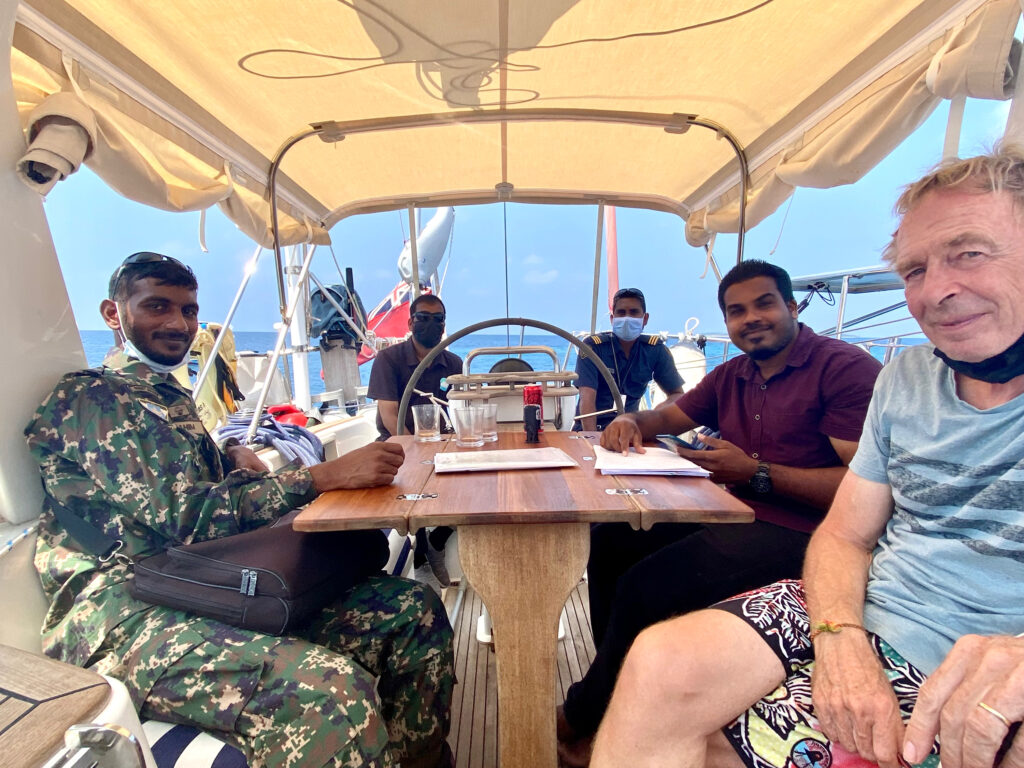

19 Comments
Paul Bayley
March 3, 2022 - 6:05 pmWow, you are a lot braver than me, it did seem a bit frightening, glad you made land or near to it. Take care. Paul
annie
March 6, 2022 - 1:38 pmThanks Paul. Not so sure about brave.. I feel decidedly wimpy at times x
Liz Harvey
March 3, 2022 - 6:43 pmWhat an incredible read this blog makes! You are an unbelievably brave couple.I certainly wouldn’t of had the guts! The picture of your swim Annie looks amazing!
annie
March 6, 2022 - 1:39 pmThanks Liz. Brave? Wimpy quite a bit of the time but the swim was amazing indeed xx
Gerard
March 3, 2022 - 7:00 pmHugh looks a little older. Must have been exciting. At least you are away from this horrible world.
annie
March 6, 2022 - 1:40 pmHugh is focussing on the word ‘little’ not ‘older’ but it’s been a while since we’ve seen you now. Hope to get together again one day x
Ken
March 3, 2022 - 7:18 pmI am in total awe. What a trip. You are both amazing.
annie
March 6, 2022 - 1:41 pmAhhh. Thanks Ken x
Annie Sparkes
March 3, 2022 - 8:42 pmMy goodness! Its so much easier by bus.
annie
March 6, 2022 - 1:41 pmTrue… but probably even more uncomfortable, 1500 miles on a bus? x
Steve
March 4, 2022 - 10:16 amWhat a lovely passage just enough weather to alleviate the boredom and no critical things breaking! Loved the picture of the full cruising chute. Hope you dont get bored on the Maldives…and you know what Nelson said…
annie
March 6, 2022 - 1:30 pmKiss me Hardy?
Avinash Jobanputra
March 4, 2022 - 10:17 amI am really impressed
annie
March 6, 2022 - 1:42 pmThanks Avinash x
Oliver Lucas
March 5, 2022 - 9:00 amAnother great read. No fishing this time?
annie
March 6, 2022 - 1:28 pmNo fishing I’m afraid… a bit too lazy!
Peter Baylis
March 5, 2022 - 12:16 pmAn amazing passage. I am reminded once again that circumnavigations are not for the faint hearted.
annie
March 6, 2022 - 1:43 pmThanks Pete. Though I feel pretty faint hearted at times 😉 x
Amanda Love
March 7, 2022 - 8:39 amBlimey Annie. Great descriptions of some truly terrifying and tricky moments. The fact that you said it was all forgotten on arrival back to land, made md think of childbirth!! Hope the next leg is easier x